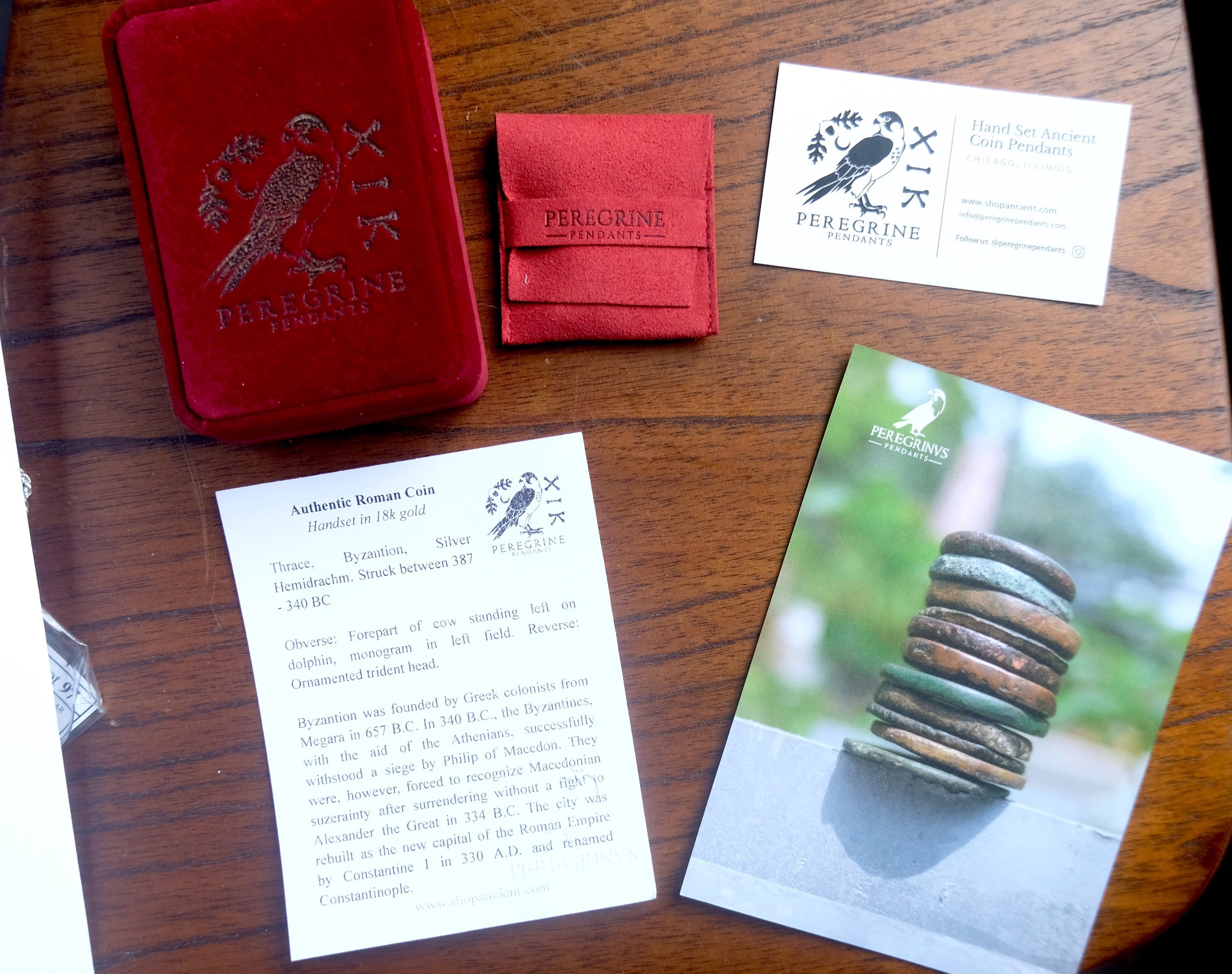 Image 1 of 4
Image 1 of 4

 Image 2 of 4
Image 2 of 4

 Image 3 of 4
Image 3 of 4

 Image 4 of 4
Image 4 of 4





Arabia - Owl - 2300 Year Old Unique Coin in 22k gold
This is a drachm in the style of the Athenian tetradrachm showing the owl and Athena. Athenian owls were very famous throughout the region, with many localities imitating the coinage. This is one such example. This size is a lot smaller than the original athenian tetradrachm, which I also sell.
I chose this prong setting because of the unique shape of the coin.
Read my blog post about Athens' owl coin: https://www.peregrinependants.com/blog/athens-owl-coin. Note how thick these coins are.
-- Coin information:
Arabia, Southern. Saba' - Imitating Athens
Obverse: helmeted head of Athena right; N (in retrograde South Arabian; mark of value) on cheek
Reverse: owl standing right, head facing; [olive spray] and crescent to left, crescent to lower right
Struck 4th–mid 2nd centuries BC
- Comes with certificate which guarantees authenticity and provides background information (listed below) on the acquired coin
- Jewelry pouch included; Pictured 14k gold chain can be purchased separately
- Interested in ancient coins? I wrote a little bit about what I find fascinating about them here: https://tinyurl.com/24pkndjw
Ancients people would sometimes chisel (test cut) a coin to determine if the coin was a good, official, solid silver or gold coin, or if it was a fourree, a plated counterfeit.
Owls on Ancient Coins Owls are depicted on many different ancient coin types but the most prolific types are the coins of ancient Athens. The ancient slang names for the coins of Athens were "owls" (but in Greek of course) and "girls" (referring to Athena on the obverse, also in Greek). "Owls" were so popular as a central currency of the ancient world that the design remained essentially unchanged and somewhat archaic long after other cities began to produce coins of a more refined artistic style. "Owls" of Athens are still very popular. For collectors, they are perhaps the most popular ancient coin type.
This is a drachm in the style of the Athenian tetradrachm showing the owl and Athena. Athenian owls were very famous throughout the region, with many localities imitating the coinage. This is one such example. This size is a lot smaller than the original athenian tetradrachm, which I also sell.
I chose this prong setting because of the unique shape of the coin.
Read my blog post about Athens' owl coin: https://www.peregrinependants.com/blog/athens-owl-coin. Note how thick these coins are.
-- Coin information:
Arabia, Southern. Saba' - Imitating Athens
Obverse: helmeted head of Athena right; N (in retrograde South Arabian; mark of value) on cheek
Reverse: owl standing right, head facing; [olive spray] and crescent to left, crescent to lower right
Struck 4th–mid 2nd centuries BC
- Comes with certificate which guarantees authenticity and provides background information (listed below) on the acquired coin
- Jewelry pouch included; Pictured 14k gold chain can be purchased separately
- Interested in ancient coins? I wrote a little bit about what I find fascinating about them here: https://tinyurl.com/24pkndjw
Ancients people would sometimes chisel (test cut) a coin to determine if the coin was a good, official, solid silver or gold coin, or if it was a fourree, a plated counterfeit.
Owls on Ancient Coins Owls are depicted on many different ancient coin types but the most prolific types are the coins of ancient Athens. The ancient slang names for the coins of Athens were "owls" (but in Greek of course) and "girls" (referring to Athena on the obverse, also in Greek). "Owls" were so popular as a central currency of the ancient world that the design remained essentially unchanged and somewhat archaic long after other cities began to produce coins of a more refined artistic style. "Owls" of Athens are still very popular. For collectors, they are perhaps the most popular ancient coin type.
This is a drachm in the style of the Athenian tetradrachm showing the owl and Athena. Athenian owls were very famous throughout the region, with many localities imitating the coinage. This is one such example. This size is a lot smaller than the original athenian tetradrachm, which I also sell.
I chose this prong setting because of the unique shape of the coin.
Read my blog post about Athens' owl coin: https://www.peregrinependants.com/blog/athens-owl-coin. Note how thick these coins are.
-- Coin information:
Arabia, Southern. Saba' - Imitating Athens
Obverse: helmeted head of Athena right; N (in retrograde South Arabian; mark of value) on cheek
Reverse: owl standing right, head facing; [olive spray] and crescent to left, crescent to lower right
Struck 4th–mid 2nd centuries BC
- Comes with certificate which guarantees authenticity and provides background information (listed below) on the acquired coin
- Jewelry pouch included; Pictured 14k gold chain can be purchased separately
- Interested in ancient coins? I wrote a little bit about what I find fascinating about them here: https://tinyurl.com/24pkndjw
Ancients people would sometimes chisel (test cut) a coin to determine if the coin was a good, official, solid silver or gold coin, or if it was a fourree, a plated counterfeit.
Owls on Ancient Coins Owls are depicted on many different ancient coin types but the most prolific types are the coins of ancient Athens. The ancient slang names for the coins of Athens were "owls" (but in Greek of course) and "girls" (referring to Athena on the obverse, also in Greek). "Owls" were so popular as a central currency of the ancient world that the design remained essentially unchanged and somewhat archaic long after other cities began to produce coins of a more refined artistic style. "Owls" of Athens are still very popular. For collectors, they are perhaps the most popular ancient coin type.








